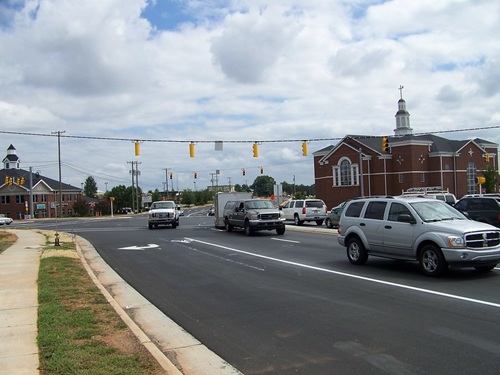The Federal Highway Administration has opened applications for up to $44.5 million in funding for projects that will strengthen safety and improve bicycling, walking, and access to public transit in communities across the country.
[Above photo by the Ohio DOT]
The agency said that grant funding – which comes through its new Active Transportation Infrastructure Investment Program or ATIIP – will help support construction of bicycle and pedestrian infrastructure, with a focus on building connected trail networks between communities.
In a statement, FHWA noted that “active transportation” centers on mobility options powered primarily by human energy, such as bicycling and walking.

As part of the program, the agency said it would award competitive grants to help communities plan, design, or construct safe and connected active transportation networks such as sidewalks, bikeways, and trails that connect destinations such as schools, workplaces, residences, businesses, recreation areas and medical facilities within a community or metropolitan region.
Grants will also be provided for projects used for trails, pedestrian facilities, bikeways, and other routes that serve as backbones to connect two or more communities, metropolitan regions, or states, FHWA said.
The agency noted that this grant funding is available for state and local agencies, tribal governments, plus metropolitan and regional planning organizations – with those applicants allowed to apply for more than one grant at a time.
This new grant program directly supports the U.S. Department of Transportation’s Blueprint for Transportation Decarbonization, which seeks to build active transportation networks that enable fewer and shorter car trips.
FHWA also plans to host an ATIIP webinar for all potential applicants on April 9 at 11:00 a.m. ET. To register, click here. A similar webinar specifically for tribal governments will be held on April 10 at 9:00 a.m. ET. To register for the tribal-focused ATTIPP webinar, click here.
State departments of transportation across the country are directly involved on their own in supporting the expansion and improvement of active transportation networks.

For example, in November 2023, the Texas Transportation Commission approved over $345 million for new sidewalks, bikeways, and other types of active transportation infrastructure projects statewide.
That went to support 83 projects designed to improve bicycle and pedestrian access while providing safety enhancements and mobility options to schools, jobs, public transit systems, and local destinations, the commission said.
In October 2023, the Rhode Island Department of Transportation helped support – in concert with various federal, state, and local agencies – the new “Gotham Greens” off-road multi-use path along the Woonasquatucket River Greenway via stormwater mitigation efforts.
This new path, located behind the Gotham Greens building in Olneyville, offers new access to the Woonasquatucket River and will serve as a connector between the Greenway and the Washington Secondary Bike Path – helping “knit together” a “patchwork of pathways” in the City of Providence to promote active transportation use while protecting the local environment from stormwater flooding.
In September 2023, Governor Wes Moore (D) of Maryland highlighted $25.5 million in grants to 40 bicycle, pedestrian and trail projects statewide. Those fiscal year 2024 grants include $20.8 million in federal funding for 22 projects through the national Transportation Alternatives Program and the Recreational Trails Program, with $4.7 million in state funding headed to 18 projects via the Kim Lamphier Bikeways Network Program overseen by the Maryland Department of Transportation.
And in July 2022, a team of Utah State University researchers issued a study detailing how Utah’s network of historic canal trails as an active transportation solution. The Utah Department of Transportation – which funded that study – is using its findings to help make decisions about building canal paths and trails and tying them into a connected active transportation network.
 Top Stories
Top Stories


